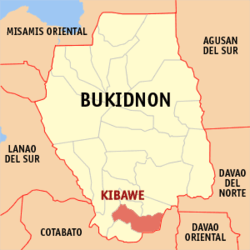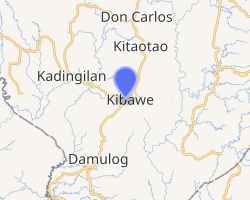Kibawe, Bukidnon
Kibawe, officially the Municipality of Kibawe, is a 2nd class municipality in the province of Bukidnon, Philippines. According to the 2015 census, it has a population of 39,612 people.[4]
Kibawe | |
|---|---|
| Municipality of Kibawe | |
Seal | |
 Map of Bukidnon with Kibawe highlighted | |
OpenStreetMap 
| |
.svg.png) Kibawe Location within the Philippines | |
| Coordinates: 7°34′N 124°59′E | |
| Country | |
| Region | Northern Mindanao (Region X) |
| Province | Bukidnon |
| District | 3rd District |
| Founded | July 1, 1956 |
| Barangays | 23 (see Barangays) |
| Government | |
| • Type | Sangguniang Bayan |
| • Mayor | Reynaldo "Jimboy Tebontu" S. Ang Rabanes |
| • Vice Mayor | Raymundo A. Batao Jr. |
| • Congressman | Manuel F. Zubiri |
| • Electorate | 25,754 voters (2019) |
| Area | |
| • Total | 304.13 km2 (117.43 sq mi) |
| Elevation | 371.3 m (1,218.2 ft) |
| Population (2015 census)[4] | |
| • Total | 39,612 |
| • Density | 130/km2 (340/sq mi) |
| • Households | 8,825 |
| Economy | |
| • Income class | 2nd municipal income class |
| • Poverty incidence | 45.3% (2015)[5] |
| • Revenue (₱) | 125,075,992.02 (2016) |
| Time zone | UTC+8 (PST) |
| ZIP code | 8720 |
| PSGC | |
| IDD : area code | +63 (0)88 |
| Climate type | tropical rainforest climate |
| Native languages | Binukid Cebuano Ata Manobo Matigsalug language Ilianen language Tagalog |
| Website | www |
History
In the early days of the American regime, Kibawe was populated by a tribe of Mamadas people. The Mamadas people were nomadic by nature and subsisted on hunting and forest products. They maintained small plots of corn, camote and gabi in places where they built their temporary shelters. They practised a feudal type of government and were responsible only to their datus who governed as their political chieftain, judge, religious leader and armed-forces chief. The most famous among the “datus” was Datu Mambantayao. Datu Mambantayao's bravery and love for his subjects were unexcelled and remain in the hearts and minds of the people to this day. One of the historic events of his life as a datu was the capturing of a lady whom he loved. She was abducted by a tribe from Bugcaon, Malaybalay, Bukidnon, seventy kilometers away from Kibawe. Datu Mambantayao, along with his armed trained warriors marched to Bugcaon, which they attacked heavily, plundering and killing the Bugcaons’ chieftain for the recovery of the lady who he later married. Datu Mambantayao named this place Kibawe from the word “Guibawe” meaning recovery.
Bukidnon was eventually created as a separate province from Agusan. Kibawe became a barrio of Maramag. It now occupied the southern portion of Bukidnon, bounded on the north by Maramag, on the south by Carmen, Cotabato, on the east by Magpet, Cotabato and on the west by Lanao Sur. It covered the present areas of the mother municipality of Kibawe, the daughter municipalities of Dangcagan, Damulog and Kadingilan and grand daughter municipality of Kitaotao, with a land area of approximately 1,250 km2 (480 sq mi)
Kibawe became a municipal district in 1931 and then became a regular municipality on July 1, 1956 under Executive Order 272 issued by then president of the Philippines, President Carlos P. Garcia. Later on, barrio Dangcagan separated into a regular municipality. The growth and development of the municipality served high after the Second World War as immigrants from all over the country (mainly from Visayas and Mindanao) came flocking into the fertile valleys and low mountains of the community.
The original populace of the town, the Manobos, have practically been replaced by the above-mentioned lowlanders. To date, only a few Manobos remain in the interior barrios. In the year 1972, the big barrios of Damulog and Kadingilan were created into separate municipalities. Thus, Kibawe retained the land area of 301.43 km2 (116.38 sq mi). The Kibaweños of today are people of diverse ethnic origin including the autochthonous Manobos and Bukidnon Lumad tribes, as well as the immigrant Cebuanos, Boholanos, Ilonggos, Negrenses and Warays. All are hardworking, friendly, peace-loving and law-abiding. Together, they work towards a common goal - the socio-economic advancement and amelioration of their lives as a whole.
Geography
Kibawe is a rich land at the center of Mindanao, located in southern Bukidnon. It is bounded in the north by the municipality of Dangcagan, on the south by the municipality of Damulog, on the east by the municipality of Magpet, North Cotabato, and on the west by the municipality of Kadingilan with Muleta River serving as a natural boundary. It has a total land area of 301.43 square kilometres (116.38 sq mi), with an approximate land elevation of 337 metres (1,106 ft) above sea level.
Topography
Kibawe has a larger percentage of rolling than plain areas. A rough estimate is 80% rolling hills and 20% plainlands. The important landmarks of the municipality are several mountain peaks, clustered over most of the barangays. Pulangi and Muleta Rivers serve as the major fishing grounds of the people residing near the bank, as do the beautiful and magnificent Paragupac Cave in Barangay Spring and the Ragubrob, and Mayabu springs at Barangay New Kidapawan.
Climate
The climate conditions of the entire municipality of Kibawe is pleasant and cool throughout the year. It is relatively dry from January to April and wet the rest of the year.
| Climate data for Kibawe, Bukidnon | |||||||||||||
|---|---|---|---|---|---|---|---|---|---|---|---|---|---|
| Month | Jan | Feb | Mar | Apr | May | Jun | Jul | Aug | Sep | Oct | Nov | Dec | Year |
| Average high °C (°F) | 28 (82) |
28 (82) |
29 (84) |
30 (86) |
30 (86) |
29 (84) |
28 (82) |
29 (84) |
29 (84) |
29 (84) |
29 (84) |
29 (84) |
29 (84) |
| Average low °C (°F) | 20 (68) |
20 (68) |
20 (68) |
21 (70) |
22 (72) |
22 (72) |
22 (72) |
22 (72) |
22 (72) |
22 (72) |
21 (70) |
20 (68) |
21 (70) |
| Average precipitation mm (inches) | 44 (1.7) |
27 (1.1) |
32 (1.3) |
35 (1.4) |
76 (3.0) |
117 (4.6) |
108 (4.3) |
108 (4.3) |
94 (3.7) |
100 (3.9) |
76 (3.0) |
46 (1.8) |
863 (34.1) |
| Average rainy days | 10.3 | 8.1 | 8.5 | 9.6 | 21.0 | 24.9 | 25.0 | 24.2 | 22.5 | 23.4 | 17.7 | 11.4 | 206.6 |
| Source: Meteoblue [6] | |||||||||||||
Barangays
Kibawe is politically subdivided into 23 barangays.
| PSGC | Barangay | Population | ±% p.a. | |||
|---|---|---|---|---|---|---|
| 2015[4] | 2010[7] | |||||
| 101308003 | Balintawak | 2.0% | 806 | 735 | 1.77% | |
| 101308006 | Cagawasan | 2.3% | 919 | 911 | 0.17% | |
| 101308007 | East Kibawe (Poblacion) | 7.7% | 3,031 | 2,777 | 1.68% | |
| 101308008 | Gutapol | 4.4% | 1,727 | 1,715 | 0.13% | |
| 101308011 | Pinamula | 3.5% | 1,400 | 1,133 | 4.11% | |
| 101308013 | Kiorao | 1.7% | 655 | 685 | −0.85% | |
| 101308014 | Kisawa | 2.1% | 843 | 750 | 2.25% | |
| 101308015 | Labuagon | 5.0% | 1,983 | 1,890 | 0.92% | |
| 101308016 | Magsaysay | 4.4% | 1,731 | 1,541 | 2.24% | |
| 101308018 | Marapangi | 5.6% | 2,206 | 2,037 | 1.53% | |
| 101308019 | Mascariñas | 1.7% | 682 | 567 | 3.58% | |
| 101308020 | Natulongan | 8.1% | 3,211 | 2,716 | 3.24% | |
| 101308021 | New Kidapawan | 4.0% | 1,587 | 1,185 | 5.72% | |
| 101308023 | Old Kibawe | 5.9% | 2,353 | 2,108 | 2.12% | |
| 101308028 | Romagooc | 6.0% | 2,384 | 2,132 | 2.15% | |
| 101308030 | Sampaguita | 3.6% | 1,431 | 1,216 | 3.15% | |
| 101308031 | Sanipon | 2.4% | 932 | 669 | 6.52% | |
| 101308032 | Spring | 3.9% | 1,551 | 1,458 | 1.18% | |
| 101308033 | Talahiron | 7.8% | 3,092 | 2,929 | 1.04% | |
| 101308034 | Tumaras | 1.9% | 767 | 670 | 2.61% | |
| 101308035 | West Kibawe (Poblacion) | 8.0% | 3,176 | 3,004 | 1.07% | |
| 101308036 | Bukang Liwayway | 2.4% | 960 | 1,037 | −1.46% | |
| 101308037 | Palma | 5.5% | 2,185 | 1,902 | 2.68% | |
| Total | 39,612 | 35,767 | 1.96% | |||
Demographics
| Population census of Kibawe | ||
|---|---|---|
| Year | Pop. | ±% p.a. |
| 1939 | 2,947 | — |
| 1948 | 5,588 | +7.37% |
| 1960 | 35,728 | +16.72% |
| 1970 | 56,239 | +4.64% |
| 1975 | 26,407 | −14.07% |
| 1980 | 26,949 | +0.41% |
| 1990 | 28,608 | +0.60% |
| 1995 | 30,783 | +1.38% |
| 2000 | 32,955 | +1.47% |
| 2007 | 35,213 | +0.92% |
| 2010 | 35,767 | +0.57% |
| 2015 | 39,612 | +1.96% |
| Source: Philippine Statistics Authority[4][7][8][9] | ||
In the 2015 census, the population of Kibawe, Bukidnon, was 39,612 people,[4] with a density of 130 inhabitants per square kilometre or 340 inhabitants per square mile.
Transportation
Kibawe is accessible by land transportation. The existing land transportation in the city consists of multicabs from nearby towns, single motorcycles, buses from Cagayan de Oro City and General Santos City, tricycles, and private vehicles facilitate the movement of people and goods to and from all places in the town. Traveling from Poblacion is mainly by land through all kinds of vehicles.
Notable people from Kibawe
- Manny Pacquiao, Filipino boxer, eight-division world champion, was born in Kibawe.[10]
References
- "Municipality". Quezon City, Philippines: Department of the Interior and Local Government. Retrieved 31 May 2013.
- "Province: Bukidnon". PSGC Interactive. Quezon City, Philippines: Philippine Statistics Authority. Retrieved 12 November 2016.
- "Kibawe, Bukidnon Profile". PhilAtlas.com. Retrieved 15 June 2020.
- Census of Population (2015). "Region X (Northern Mindanao)". Total Population by Province, City, Municipality and Barangay. PSA. Retrieved 20 June 2016.
- "PSA releases the 2015 Municipal and City Level Poverty Estimates". Quezon City, Philippines. Retrieved 12 October 2019.
- "Kibawe: Average Temperatures and Rainfall". Meteoblue. Retrieved 29 April 2020.
- Census of Population and Housing (2010). "Region X (Northern Mindanao)". Total Population by Province, City, Municipality and Barangay. NSO. Retrieved 29 June 2016.
- Censuses of Population (1903–2007). "Region X (Northern Mindanao)". Table 1. Population Enumerated in Various Censuses by Province/Highly Urbanized City: 1903 to 2007. NSO.
- "Province of Bukidnon". Municipality Population Data. Local Water Utilities Administration Research Division. Retrieved 17 December 2016.
- Philboxing.com Archived 2007-05-02 at the Wayback Machine